Occupational Therapy Interventions Improving PTSD Symptoms
VerifiedAdded on 2023/06/11
|7
|1378
|324
Report
AI Summary
This report investigates the effectiveness of occupational therapy interventions in improving symptoms of post-traumatic stress disorder (PTSD) in adults within inpatient rehabilitation settings. A systematic review of peer-reviewed articles from databases such as PILOTS, PsychINFO, and CINAHL Plus, focusing on the last 10 years, was conducted. The analysis reveals that residential training programs, sports and movement therapy, and cognitive processing therapy (CPT) show promise in reducing PTSD symptoms among veterans. Key findings highlight the importance of in-house residential setups with trained occupational therapists and the use of tools like the PTSD checklist, Canadian Occupational Performance Measure, and Clinician-Administered PTSD Scale for evaluating treatment outcomes. The report concludes that a comprehensive, interdisciplinary approach is crucial for enhancing occupational performance and mental satisfaction in individuals with PTSD undergoing inpatient rehabilitation.
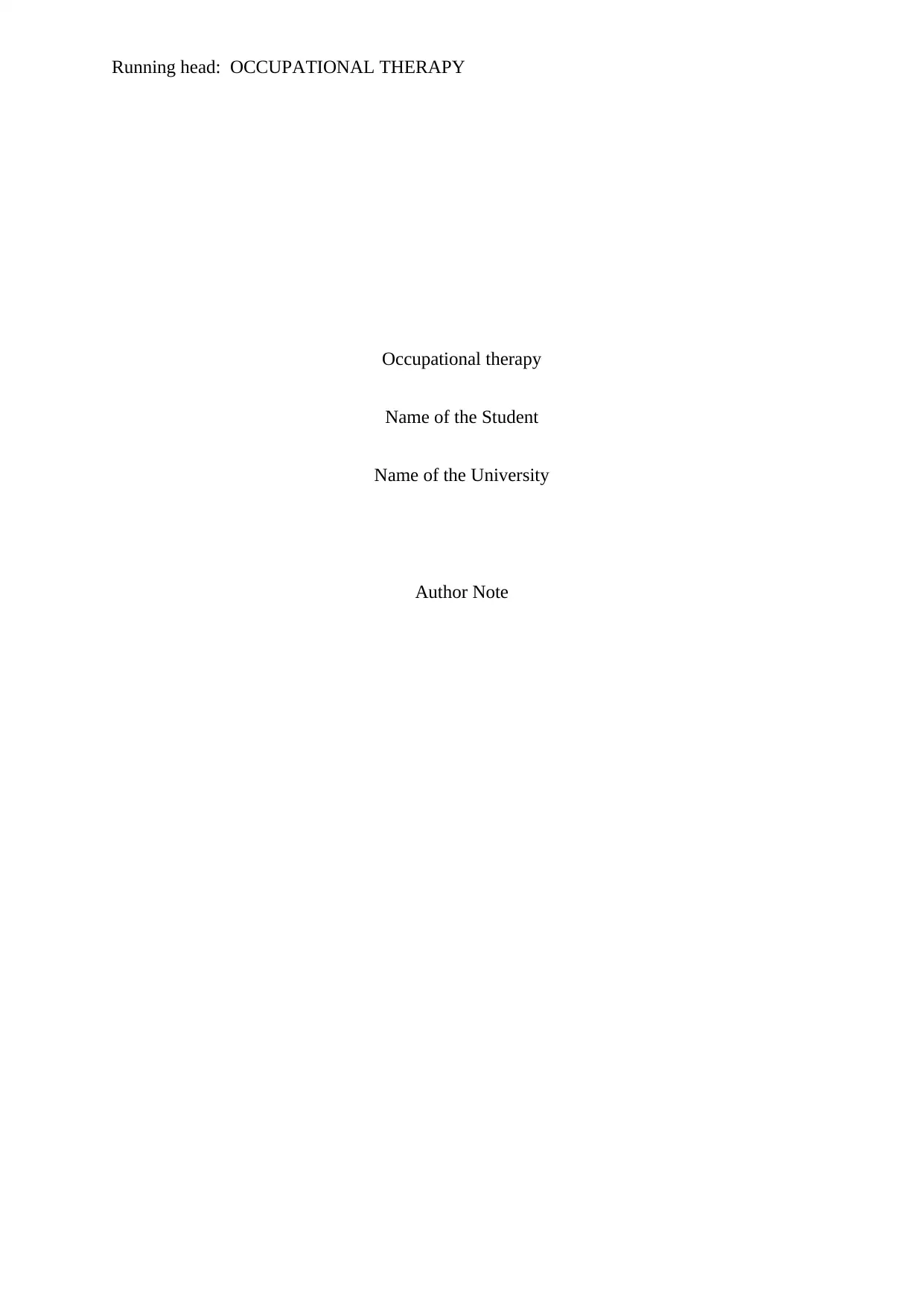
Running head: OCCUPATIONAL THERAPY
Occupational therapy
Name of the Student
Name of the University
Author Note
Occupational therapy
Name of the Student
Name of the University
Author Note
Paraphrase This Document
Need a fresh take? Get an instant paraphrase of this document with our AI Paraphraser
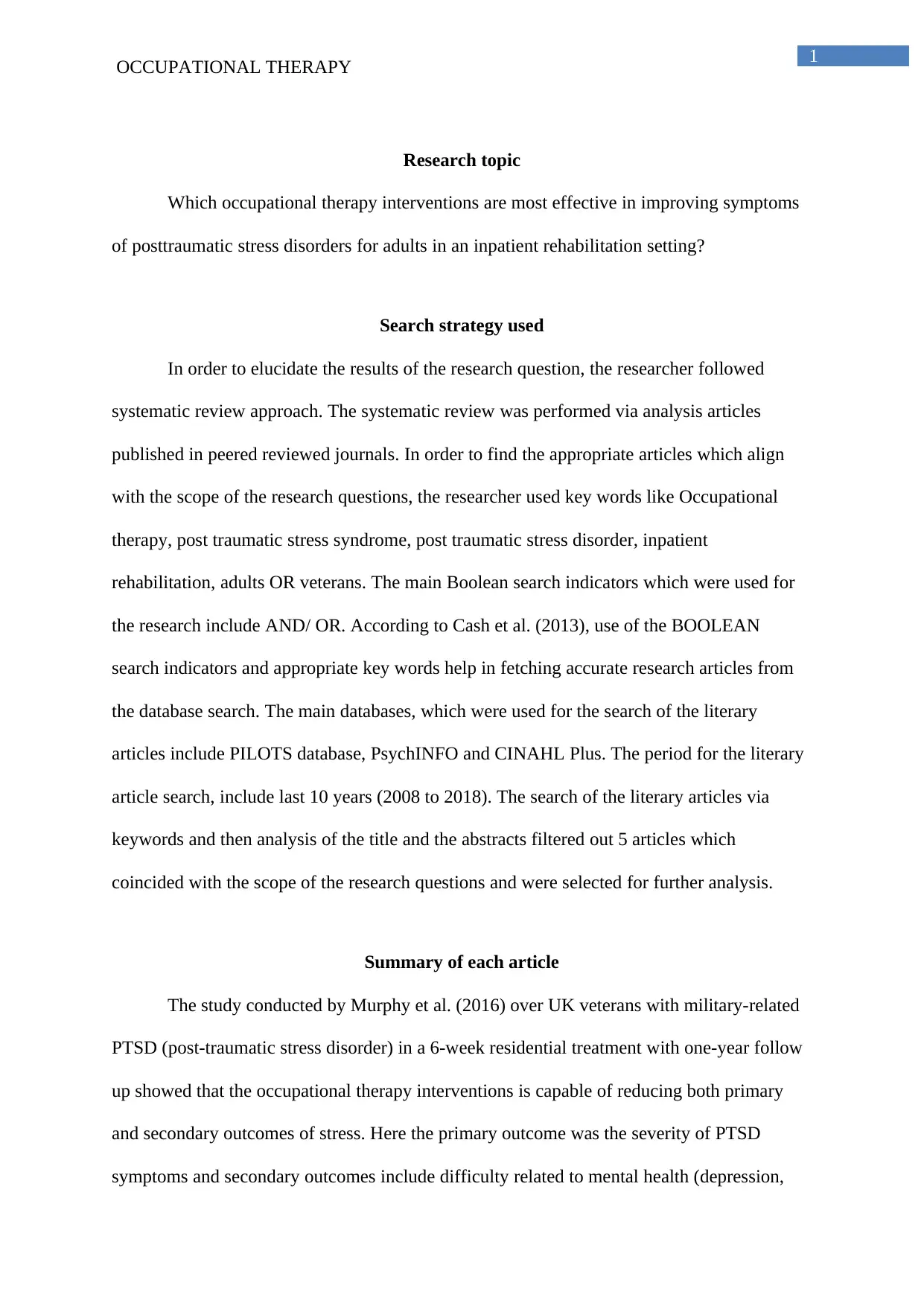
1
OCCUPATIONAL THERAPY
Research topic
Which occupational therapy interventions are most effective in improving symptoms
of posttraumatic stress disorders for adults in an inpatient rehabilitation setting?
Search strategy used
In order to elucidate the results of the research question, the researcher followed
systematic review approach. The systematic review was performed via analysis articles
published in peered reviewed journals. In order to find the appropriate articles which align
with the scope of the research questions, the researcher used key words like Occupational
therapy, post traumatic stress syndrome, post traumatic stress disorder, inpatient
rehabilitation, adults OR veterans. The main Boolean search indicators which were used for
the research include AND/ OR. According to Cash et al. (2013), use of the BOOLEAN
search indicators and appropriate key words help in fetching accurate research articles from
the database search. The main databases, which were used for the search of the literary
articles include PILOTS database, PsychINFO and CINAHL Plus. The period for the literary
article search, include last 10 years (2008 to 2018). The search of the literary articles via
keywords and then analysis of the title and the abstracts filtered out 5 articles which
coincided with the scope of the research questions and were selected for further analysis.
Summary of each article
The study conducted by Murphy et al. (2016) over UK veterans with military-related
PTSD (post-traumatic stress disorder) in a 6-week residential treatment with one-year follow
up showed that the occupational therapy interventions is capable of reducing both primary
and secondary outcomes of stress. Here the primary outcome was the severity of PTSD
symptoms and secondary outcomes include difficulty related to mental health (depression,
OCCUPATIONAL THERAPY
Research topic
Which occupational therapy interventions are most effective in improving symptoms
of posttraumatic stress disorders for adults in an inpatient rehabilitation setting?
Search strategy used
In order to elucidate the results of the research question, the researcher followed
systematic review approach. The systematic review was performed via analysis articles
published in peered reviewed journals. In order to find the appropriate articles which align
with the scope of the research questions, the researcher used key words like Occupational
therapy, post traumatic stress syndrome, post traumatic stress disorder, inpatient
rehabilitation, adults OR veterans. The main Boolean search indicators which were used for
the research include AND/ OR. According to Cash et al. (2013), use of the BOOLEAN
search indicators and appropriate key words help in fetching accurate research articles from
the database search. The main databases, which were used for the search of the literary
articles include PILOTS database, PsychINFO and CINAHL Plus. The period for the literary
article search, include last 10 years (2008 to 2018). The search of the literary articles via
keywords and then analysis of the title and the abstracts filtered out 5 articles which
coincided with the scope of the research questions and were selected for further analysis.
Summary of each article
The study conducted by Murphy et al. (2016) over UK veterans with military-related
PTSD (post-traumatic stress disorder) in a 6-week residential treatment with one-year follow
up showed that the occupational therapy interventions is capable of reducing both primary
and secondary outcomes of stress. Here the primary outcome was the severity of PTSD
symptoms and secondary outcomes include difficulty related to mental health (depression,
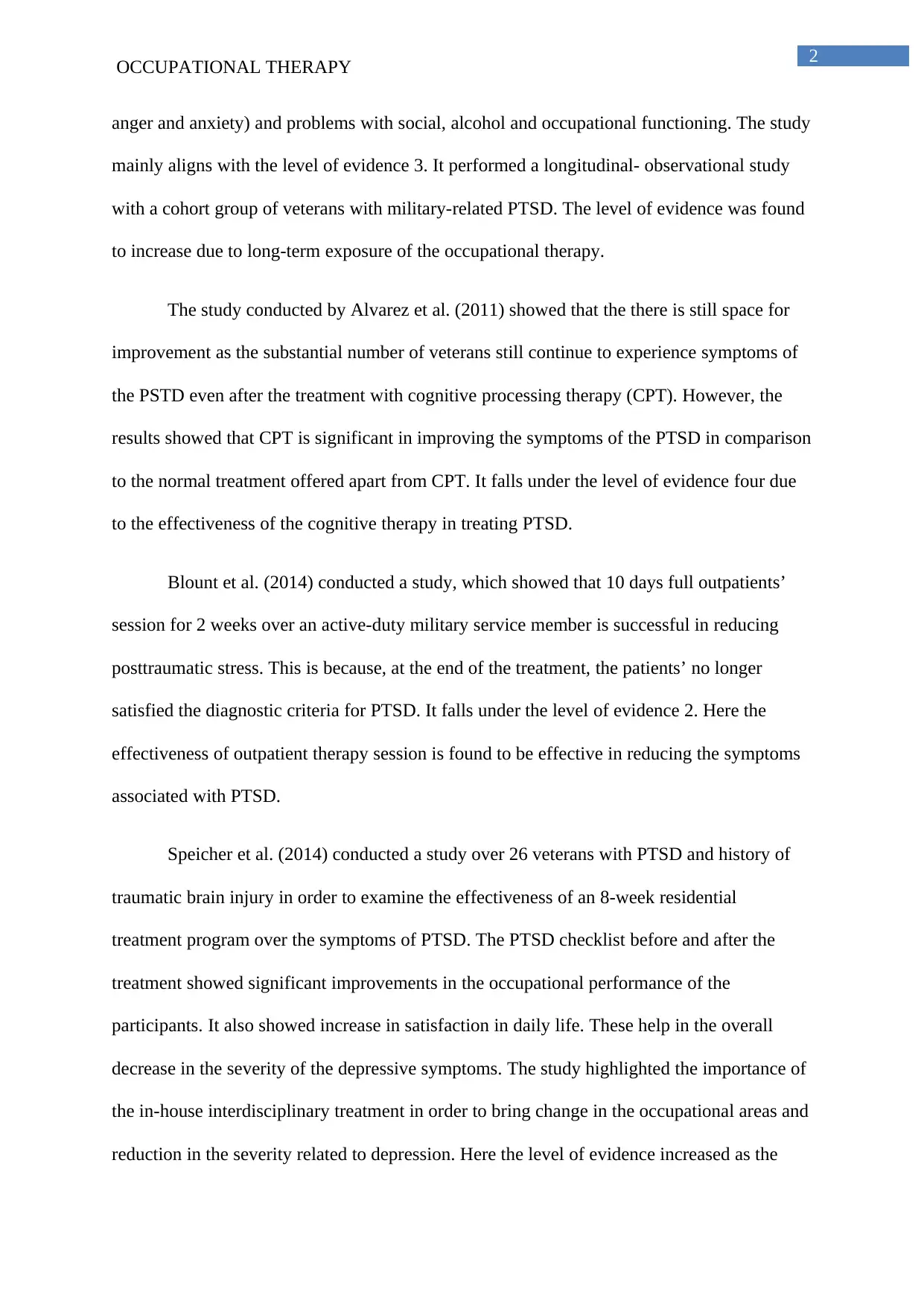
2
OCCUPATIONAL THERAPY
anger and anxiety) and problems with social, alcohol and occupational functioning. The study
mainly aligns with the level of evidence 3. It performed a longitudinal- observational study
with a cohort group of veterans with military-related PTSD. The level of evidence was found
to increase due to long-term exposure of the occupational therapy.
The study conducted by Alvarez et al. (2011) showed that the there is still space for
improvement as the substantial number of veterans still continue to experience symptoms of
the PSTD even after the treatment with cognitive processing therapy (CPT). However, the
results showed that CPT is significant in improving the symptoms of the PTSD in comparison
to the normal treatment offered apart from CPT. It falls under the level of evidence four due
to the effectiveness of the cognitive therapy in treating PTSD.
Blount et al. (2014) conducted a study, which showed that 10 days full outpatients’
session for 2 weeks over an active-duty military service member is successful in reducing
posttraumatic stress. This is because, at the end of the treatment, the patients’ no longer
satisfied the diagnostic criteria for PTSD. It falls under the level of evidence 2. Here the
effectiveness of outpatient therapy session is found to be effective in reducing the symptoms
associated with PTSD.
Speicher et al. (2014) conducted a study over 26 veterans with PTSD and history of
traumatic brain injury in order to examine the effectiveness of an 8-week residential
treatment program over the symptoms of PTSD. The PTSD checklist before and after the
treatment showed significant improvements in the occupational performance of the
participants. It also showed increase in satisfaction in daily life. These help in the overall
decrease in the severity of the depressive symptoms. The study highlighted the importance of
the in-house interdisciplinary treatment in order to bring change in the occupational areas and
reduction in the severity related to depression. Here the level of evidence increased as the
OCCUPATIONAL THERAPY
anger and anxiety) and problems with social, alcohol and occupational functioning. The study
mainly aligns with the level of evidence 3. It performed a longitudinal- observational study
with a cohort group of veterans with military-related PTSD. The level of evidence was found
to increase due to long-term exposure of the occupational therapy.
The study conducted by Alvarez et al. (2011) showed that the there is still space for
improvement as the substantial number of veterans still continue to experience symptoms of
the PSTD even after the treatment with cognitive processing therapy (CPT). However, the
results showed that CPT is significant in improving the symptoms of the PTSD in comparison
to the normal treatment offered apart from CPT. It falls under the level of evidence four due
to the effectiveness of the cognitive therapy in treating PTSD.
Blount et al. (2014) conducted a study, which showed that 10 days full outpatients’
session for 2 weeks over an active-duty military service member is successful in reducing
posttraumatic stress. This is because, at the end of the treatment, the patients’ no longer
satisfied the diagnostic criteria for PTSD. It falls under the level of evidence 2. Here the
effectiveness of outpatient therapy session is found to be effective in reducing the symptoms
associated with PTSD.
Speicher et al. (2014) conducted a study over 26 veterans with PTSD and history of
traumatic brain injury in order to examine the effectiveness of an 8-week residential
treatment program over the symptoms of PTSD. The PTSD checklist before and after the
treatment showed significant improvements in the occupational performance of the
participants. It also showed increase in satisfaction in daily life. These help in the overall
decrease in the severity of the depressive symptoms. The study highlighted the importance of
the in-house interdisciplinary treatment in order to bring change in the occupational areas and
reduction in the severity related to depression. Here the level of evidence increased as the
⊘ This is a preview!⊘
Do you want full access?
Subscribe today to unlock all pages.

Trusted by 1+ million students worldwide
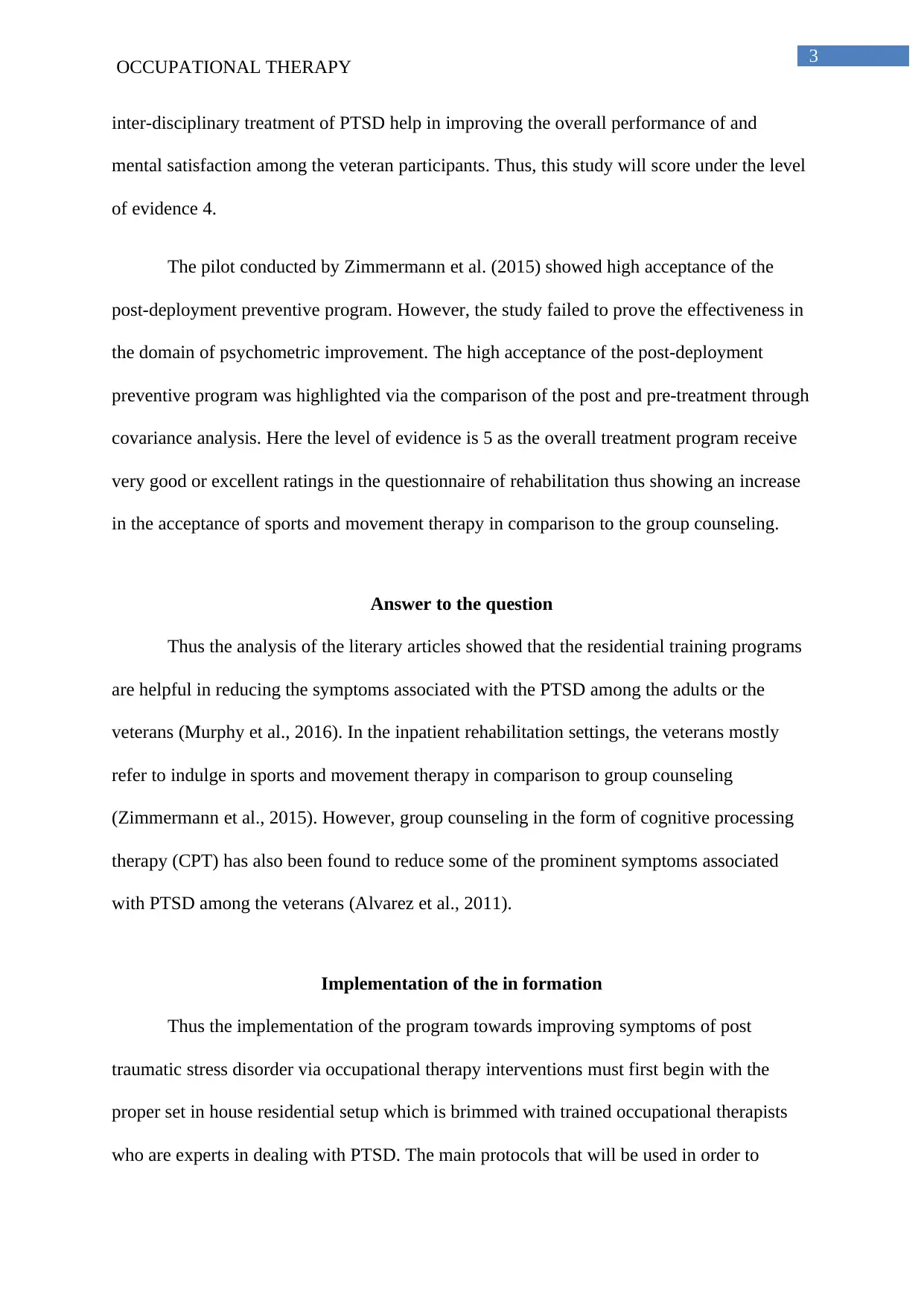
3
OCCUPATIONAL THERAPY
inter-disciplinary treatment of PTSD help in improving the overall performance of and
mental satisfaction among the veteran participants. Thus, this study will score under the level
of evidence 4.
The pilot conducted by Zimmermann et al. (2015) showed high acceptance of the
post-deployment preventive program. However, the study failed to prove the effectiveness in
the domain of psychometric improvement. The high acceptance of the post-deployment
preventive program was highlighted via the comparison of the post and pre-treatment through
covariance analysis. Here the level of evidence is 5 as the overall treatment program receive
very good or excellent ratings in the questionnaire of rehabilitation thus showing an increase
in the acceptance of sports and movement therapy in comparison to the group counseling.
Answer to the question
Thus the analysis of the literary articles showed that the residential training programs
are helpful in reducing the symptoms associated with the PTSD among the adults or the
veterans (Murphy et al., 2016). In the inpatient rehabilitation settings, the veterans mostly
refer to indulge in sports and movement therapy in comparison to group counseling
(Zimmermann et al., 2015). However, group counseling in the form of cognitive processing
therapy (CPT) has also been found to reduce some of the prominent symptoms associated
with PTSD among the veterans (Alvarez et al., 2011).
Implementation of the in formation
Thus the implementation of the program towards improving symptoms of post
traumatic stress disorder via occupational therapy interventions must first begin with the
proper set in house residential setup which is brimmed with trained occupational therapists
who are experts in dealing with PTSD. The main protocols that will be used in order to
OCCUPATIONAL THERAPY
inter-disciplinary treatment of PTSD help in improving the overall performance of and
mental satisfaction among the veteran participants. Thus, this study will score under the level
of evidence 4.
The pilot conducted by Zimmermann et al. (2015) showed high acceptance of the
post-deployment preventive program. However, the study failed to prove the effectiveness in
the domain of psychometric improvement. The high acceptance of the post-deployment
preventive program was highlighted via the comparison of the post and pre-treatment through
covariance analysis. Here the level of evidence is 5 as the overall treatment program receive
very good or excellent ratings in the questionnaire of rehabilitation thus showing an increase
in the acceptance of sports and movement therapy in comparison to the group counseling.
Answer to the question
Thus the analysis of the literary articles showed that the residential training programs
are helpful in reducing the symptoms associated with the PTSD among the adults or the
veterans (Murphy et al., 2016). In the inpatient rehabilitation settings, the veterans mostly
refer to indulge in sports and movement therapy in comparison to group counseling
(Zimmermann et al., 2015). However, group counseling in the form of cognitive processing
therapy (CPT) has also been found to reduce some of the prominent symptoms associated
with PTSD among the veterans (Alvarez et al., 2011).
Implementation of the in formation
Thus the implementation of the program towards improving symptoms of post
traumatic stress disorder via occupational therapy interventions must first begin with the
proper set in house residential setup which is brimmed with trained occupational therapists
who are experts in dealing with PTSD. The main protocols that will be used in order to
Paraphrase This Document
Need a fresh take? Get an instant paraphrase of this document with our AI Paraphraser
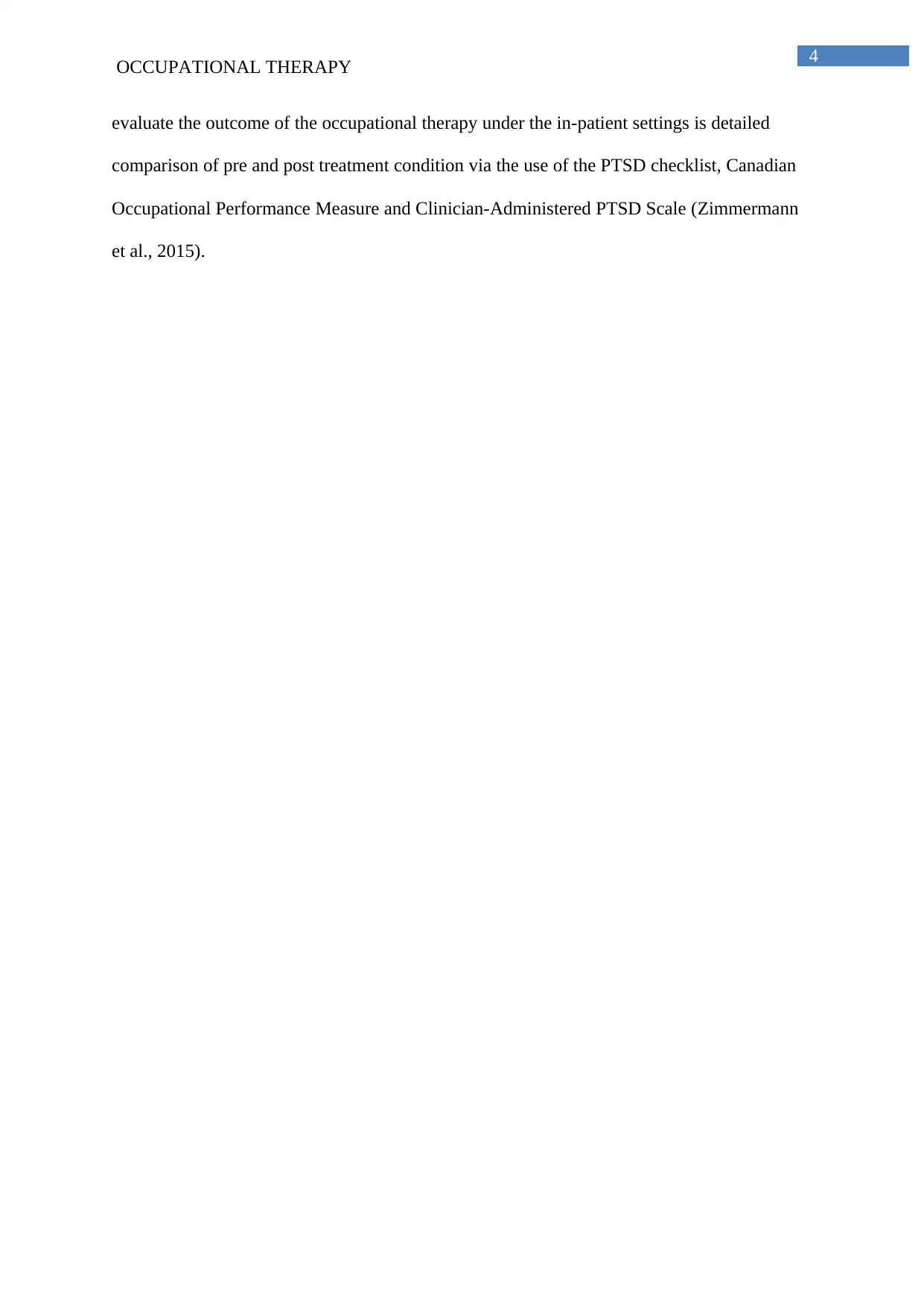
4
OCCUPATIONAL THERAPY
evaluate the outcome of the occupational therapy under the in-patient settings is detailed
comparison of pre and post treatment condition via the use of the PTSD checklist, Canadian
Occupational Performance Measure and Clinician-Administered PTSD Scale (Zimmermann
et al., 2015).
OCCUPATIONAL THERAPY
evaluate the outcome of the occupational therapy under the in-patient settings is detailed
comparison of pre and post treatment condition via the use of the PTSD checklist, Canadian
Occupational Performance Measure and Clinician-Administered PTSD Scale (Zimmermann
et al., 2015).
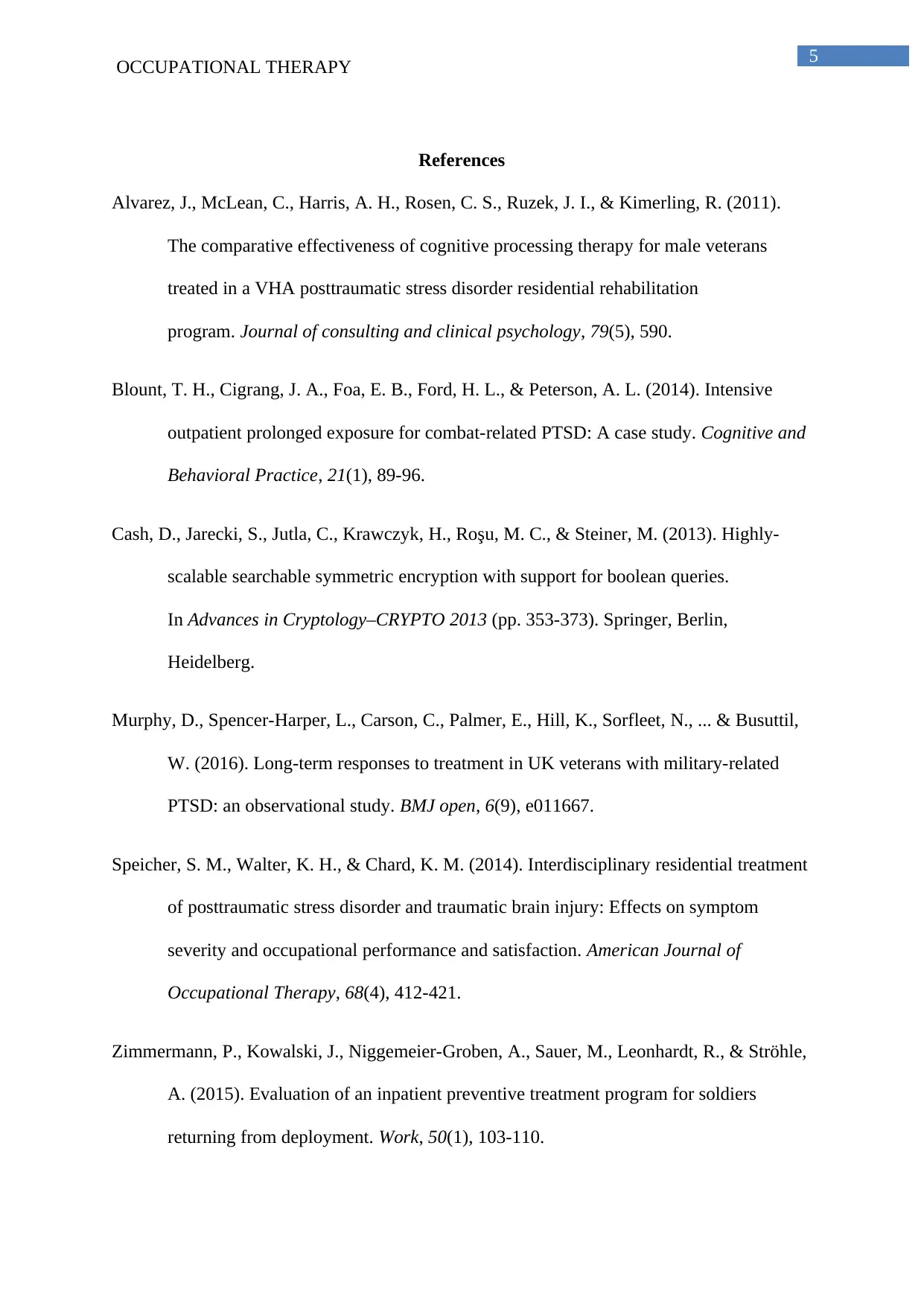
5
OCCUPATIONAL THERAPY
References
Alvarez, J., McLean, C., Harris, A. H., Rosen, C. S., Ruzek, J. I., & Kimerling, R. (2011).
The comparative effectiveness of cognitive processing therapy for male veterans
treated in a VHA posttraumatic stress disorder residential rehabilitation
program. Journal of consulting and clinical psychology, 79(5), 590.
Blount, T. H., Cigrang, J. A., Foa, E. B., Ford, H. L., & Peterson, A. L. (2014). Intensive
outpatient prolonged exposure for combat-related PTSD: A case study. Cognitive and
Behavioral Practice, 21(1), 89-96.
Cash, D., Jarecki, S., Jutla, C., Krawczyk, H., Roşu, M. C., & Steiner, M. (2013). Highly-
scalable searchable symmetric encryption with support for boolean queries.
In Advances in Cryptology–CRYPTO 2013 (pp. 353-373). Springer, Berlin,
Heidelberg.
Murphy, D., Spencer-Harper, L., Carson, C., Palmer, E., Hill, K., Sorfleet, N., ... & Busuttil,
W. (2016). Long-term responses to treatment in UK veterans with military-related
PTSD: an observational study. BMJ open, 6(9), e011667.
Speicher, S. M., Walter, K. H., & Chard, K. M. (2014). Interdisciplinary residential treatment
of posttraumatic stress disorder and traumatic brain injury: Effects on symptom
severity and occupational performance and satisfaction. American Journal of
Occupational Therapy, 68(4), 412-421.
Zimmermann, P., Kowalski, J., Niggemeier-Groben, A., Sauer, M., Leonhardt, R., & Ströhle,
A. (2015). Evaluation of an inpatient preventive treatment program for soldiers
returning from deployment. Work, 50(1), 103-110.
OCCUPATIONAL THERAPY
References
Alvarez, J., McLean, C., Harris, A. H., Rosen, C. S., Ruzek, J. I., & Kimerling, R. (2011).
The comparative effectiveness of cognitive processing therapy for male veterans
treated in a VHA posttraumatic stress disorder residential rehabilitation
program. Journal of consulting and clinical psychology, 79(5), 590.
Blount, T. H., Cigrang, J. A., Foa, E. B., Ford, H. L., & Peterson, A. L. (2014). Intensive
outpatient prolonged exposure for combat-related PTSD: A case study. Cognitive and
Behavioral Practice, 21(1), 89-96.
Cash, D., Jarecki, S., Jutla, C., Krawczyk, H., Roşu, M. C., & Steiner, M. (2013). Highly-
scalable searchable symmetric encryption with support for boolean queries.
In Advances in Cryptology–CRYPTO 2013 (pp. 353-373). Springer, Berlin,
Heidelberg.
Murphy, D., Spencer-Harper, L., Carson, C., Palmer, E., Hill, K., Sorfleet, N., ... & Busuttil,
W. (2016). Long-term responses to treatment in UK veterans with military-related
PTSD: an observational study. BMJ open, 6(9), e011667.
Speicher, S. M., Walter, K. H., & Chard, K. M. (2014). Interdisciplinary residential treatment
of posttraumatic stress disorder and traumatic brain injury: Effects on symptom
severity and occupational performance and satisfaction. American Journal of
Occupational Therapy, 68(4), 412-421.
Zimmermann, P., Kowalski, J., Niggemeier-Groben, A., Sauer, M., Leonhardt, R., & Ströhle,
A. (2015). Evaluation of an inpatient preventive treatment program for soldiers
returning from deployment. Work, 50(1), 103-110.
⊘ This is a preview!⊘
Do you want full access?
Subscribe today to unlock all pages.

Trusted by 1+ million students worldwide

6
OCCUPATIONAL THERAPY
OCCUPATIONAL THERAPY
1 out of 7
Related Documents
Your All-in-One AI-Powered Toolkit for Academic Success.
+13062052269
info@desklib.com
Available 24*7 on WhatsApp / Email
![[object Object]](/_next/static/media/star-bottom.7253800d.svg)
Unlock your academic potential
Copyright © 2020–2025 A2Z Services. All Rights Reserved. Developed and managed by ZUCOL.





